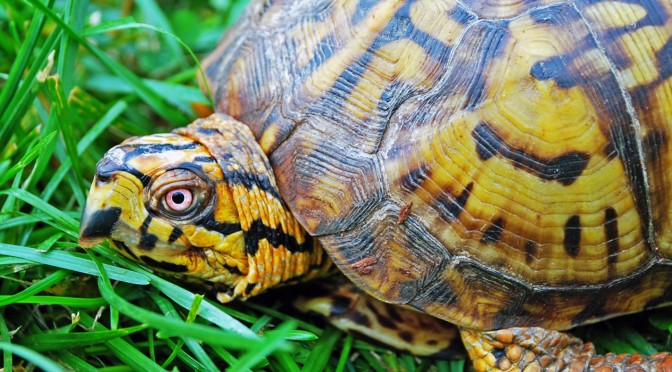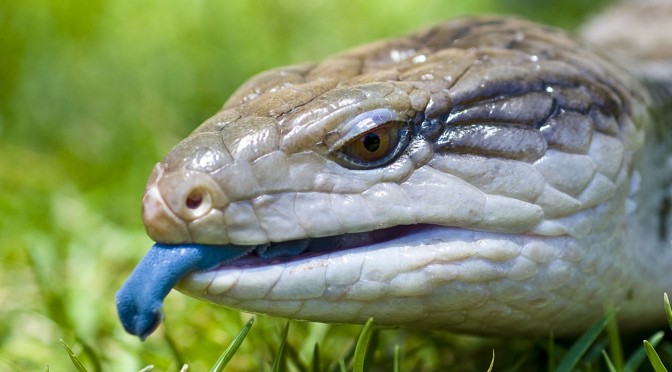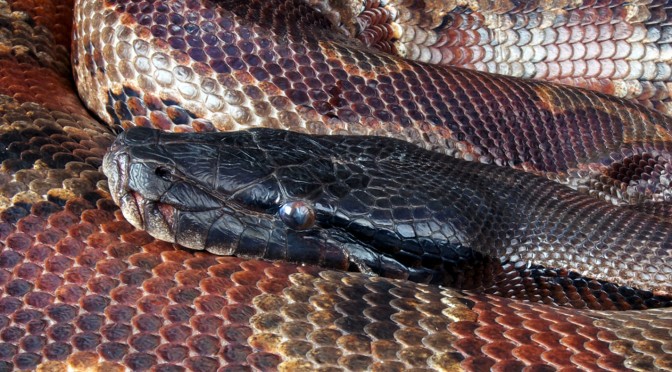NOTE: Education Animals are “behind-the-scenes” animals & only appear to the public during Educational events. This includes scheduled events or programs such as daily animal mingles, private onsite programs, and zoo reaches. For more information, please reach out to edureservations@lvzoo.org.
Program and General Information
The Blood Python is medium to large-sized, non-venomous snake species found in the Malay Peninsula, Thailand, Sumatra, and other smaller islands. They inhabit forested hills, marshes, and tropical swamps. These snakes can reach an average of 4-6 feet in length and weigh up to 30 pounds. Females are larger than males overall, but males tend to have longer tails. Their body color ranges from tan, brown, and yellow to a cherry red, bright red, or oxblood. Lighter gold, tan, or orange and black blotches and stripes overlay the main body color. The belly is usually white, very often with small blackish markings. Blood pythons are carnivores that eat mainly small mammals, but will also consume birds as well.
Breeding season likely occurs in late fall/winter. Females are oviparous and about 60-70 days after a successful mate will lay 12-30 eggs. Hatchlings will emerge after 2-3 months and mature around 2-4 years old. Snakes are becoming more popular in the pet trade. By purchasing and owning an exotic animal, you could be supporting the illegal exotic pet trade so be sure to do your research and only purchase from reputable breeders.
Diet
Blood pythons will prey upon small mammals and occasionally birds. Rats, mice, and other rodents make up the majority of their diet.
These pythons are more active during the night and will often hide under leaves, brush, or in the water to ambush prey.
They are non-venomous snakes, like all pythons, and kill their prey by constriction. After biting their prey, they wrap around it and squeeze tighter every time the prey lets out a breath, until the prey is dead. Blood pythons then swallow the item whole. They are also aided by heat-sensing pits on their upper lips that help them to detect their warm-blooded prey.
Habitat and Range
Blood pythons are native to the low forested hills, marshes, and tropical swamps of Indonesia, Thailand, and Malaysia. Unconfirmed records state that these snakes may be found in several other countries, like Singapore, but it is more likely that they were introduced there by humans.
They have been known to exist well in human populated areas and are especially found in oil palm plantations where they feed on rodents attracted to the area. It is believed that the ability to thrive in these human-modified areas is leading to an increase in the general population of the species.
Common Physical Features
Blood pythons are a medium to large-sized snake. The blood python is a thick bodied snake with a long, broad head and short tail that tapers at the end. They can reach an average height of 4-6 feet (some individuals can grow to 8 feet, but that is very rare) and weigh up to 30 pounds. Females tend to be larger than males, but have shorter tails. Blood pythons range greatly in coloration, from a dark brown to a light yellow.
The head is usually gray, although some specimens may exhibit a black or even reddish head, they are also known for their changing head colors. So a black-headed snake in the morning could have a very pale, faded head coloration in the evening and vice versa. They are the only species of the three short-tailed pythons with a red color phase – leading to this snake’s common name “blood python.” Individuals with the red color phase have patterns of rich, bright red to orange, to a duller rusty red ground color. The main color pattern of each snake is overlaid with yellow and tan blotches and stripes that run the length of the body, as well as tan and black spots that extend up the sides. The belly is usually white, very often with small, blackish markings. Those with the blood red color phase go through a gradual, yet significant, color change prior to maturity.
Adaptations: Blood pythons have adapted to hunt better during the night when they are most active. Above their lip they have heat-seeking pits, which are able to detect wavelengths of light in the infrared spectrum and the signal is processed visually, meaning, they are capable of seeing a thermal image of their surroundings giving them an advantage in hunting in the dark as well as seeking out refuges when temperatures are too hot or cold.
Snakes have an interesting way of sniffing out their prey items. Like other reptile species, ball pythons have a Jacobson’s organ in the roof of their mouth. They will stick out their tongue in order to pick up scent particles in the air or from the surface of objects. Their tongues are forked at the end, splitting in two directions in a V-shape, allowing the snake to pick up scent particles from two different directions. When the tongue is brought into the mouth to the Jacobson’s organ, the organ will process the information and determine which side of the tongue the scents came from. This will inform the snake which direction to go to find that scent. (If it picks up the scent on the left fork, then it knows to go to the left. If it picks it up on the right, then it goes to the right. And then if it picks up the scent on both forks then it knows the scent is coming from straight ahead. )
Pythons are ambush predators; they will sit and wait for their prey to come to them; blood pythons typically hide either in the leaves and brush, or in the water. Like other snakes, they do not have moveable eyelids. Instead, they have a special clear scale that covers the eyes, making them appear to be always awake. Not having eyelids allows pythons to refrain from blinking and keep their cover when camouflaged. Once a prey is close enough, they will grab the prey and wrap tightly around it.
They have powerful body muscles to squeeze and suffocate prey. Snakes have a highly flexible skull that allows them to swallow their prey whole. Contrary to popular belief, they do not actually unhinge/dislocate their jaws to swallow prey because there isn’t anything to actually unhinge/dislocate! A snake’s jaw is only loosely joined to its skull by ligaments, which allows the jaw to be solid enough to bite, but flexible enough to expand for swallowing. Once prey is inside the mouth, the snake alternate using the left and right sides of the upper and lower jaws to “walk” the prey to the back of the throat where powerful muscles will help force the prey down the rest of the body. To better visualize the movement of the jaw imagine laying on your stomach and crawling using your elbows and knees to move. That is similar to how the snake’s upper and lower jaws work to push the food into the mouth and down the throat.
Behavior and Life Cycle
Breeding season for the blood python likely occurs in late fall/winter. Females are oviparous and about 60-70 days after a successful mate will lay 12-30 eggs. Unlike most snakes, pythons do not leave their eggs and will stay coiled around them during the incubation period for temperature and humidity control. Since pythons cannot regulate their internal body temperature, they cannot incubate their eggs per se; instead, they raise the temperature of their eggs by small movements of their body (known as thermogenesis). Because of this, they may lose half their body weight during incubation.
After a 2.5 – 3 month incubation period, hatchlings will emerge from the eggs. These hatchlings are about 12 – 14 inches long and generally shed for the first time between the ages of 2-4 months. They are independent and will mature between 2-4 years of age.
Conservation Messaging
Purposeful Pet Ownership
Many snake species are becoming more popular in the pet trade. Blood pythons are large snakes and can live for quite a long time, and many people are not properly equipped to handle such a large snake species. While reptile might seem like an easy pet, you may not realize just how much work goes into caring for them. Reptiles require specific lighting, humidity, space, nutrients, substrate, heating, and if they do not receive the proper care then that reptile’s health can decline rapidly. It can be difficult to find veterinarians that are equipped to care for reptiles if they get sick.
By purchasing and owning an exotic animal, you could be supporting the illegal exotic pet trade. Oftentimes these exotic pets are taken out of their natural habitat to be sold in the pet trade, which can be detrimental to wild populations. One more exotic pet in captivity is one less animal in the wild which is resulting in species population numbers dropping drastically.
What can we do?: Be sure to fully research any pet before buying one. While you may think a reptile would make a cool pet, it’s important to know all of the care that goes into providing that animal with the best possible welfare, and as mentioned before reptiles require a lot of extra care. It is important to make sure that if you do buy an exotic pet that you are buying it from a reputable breeder, someone who knows how to properly care for the animal and hasn’t taken that animal from its natural habitat.
Do not release an unwanted pet into the wild. While you may think that you are doing something good by releasing the animal back into the wild, animals that have been kept under human care often do not know how to survive on their own out in the wild and could end up getting hurt or dying if left to their own devices.
Fun Facts
- Also known as Brongersma’s Short-tailed Python or Red Short-tailed Python. This snake was originally considered as subspecies of Python curtus but was recently upgraded to its own species in 2001.
- They spend most of their time underwater waiting to ambush their prey.
- A special tube on the bottom of its mouth stays open to one side of the mouth so it can breathe while swallowing.
- In Thailand, they are called ngoo lahm pad ped.
- Despite the fact that these pythons appear stout and don’t move around much, scales on their belly are designed to grip the bark of trees making them good climbers.
- Although the increase in palm oil plantations is potentially benefitting this snake species, palm oil plantations are the leading source of rainforest destruction in Malaysia and Indonesia and are negatively impacting the survival of endangered animals.
- Blood Pythons are hunted frequently for their scales for leather. 50,000 skins are reported to CITES by Indonesia every year. Be careful when buying leather or snake skin. Do not buy leather or fur from real animals.
Bibliography










